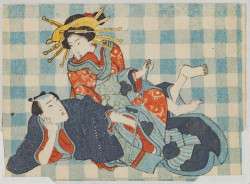
March 4, 2010
Rethinking Japanese
Traditional approaches to language learning are changing
By Metropolis
Originally published on metropolis.co.jp on March 2010

Illustration by Kohji Shiiki
The Dark Side of Japanese
Why can’t learning nihongo be a hobby rather than a struggle?
Japanese sits across from you. You’ve found yourself drawn in by his little ways, the words he speaks: so alien, and yet so beautiful! A language you’ve found fascinating like no other.
He looks you in the eye, and asks: “Please fill in the blank. Ni tsuite, or ni totte?”
You leap up. “That’s it,” you say. “Always with the questions! I’m getting a divorce.”
Here’s the received wisdom of learning Japanese:
#1: “Want to learn Japanese? It’s difficult. You’ve practically failed already.”
#2: “Fill in the blanks. Memorize this list. Write these kanji a thousand times.”
Small wonder Japanese has a reputation for flummoxing even the most ardent learners. From day one, the language is set up as an unassailable mountain with no summit.
Yet some have found an easier ascent. I call it the “dark side,” because it’s the easier way to power in the Force—I mean, Japanese. You can stick with Yoda, meditate and lift rocks in the air, or you can choose the quick and easy path, as Vader did, and choke people and shoot lightning bolts.
And what’s wrong with that?
“Khatzumoto,” of the website All Japanese All The Time, eschewed classes in favor of self-study. As a successful dieter swaps breakfast waffles for muesli, Khatzumoto—while living in the US—replaced Western culture with Japanese. Watching a Hollywood movie? He saw the Japanese dub. Procrastinating on Wikipedia? It was on the Japanese one.
After two years of rigorously studying these materials, he became fluent enough to land a job with a Japanese software company, without taking a single class.
True, Khatzumoto’s a rare example. Many set out to learn Japanese through real media and end up floundering. But coupled with the framework of a supporting syllabus, it might just be the best way to learn. After all, isn’t the culture why we love this place?
This is a concept lost in the teaching of Japanese, with its emphasis on dry textbook language. With kanji, I was taught to learn by muscle-burning repetition. This I tried, but seconds after the weekly test I’d forgotten half of them. I knew about mnemonics—visualizing characters as stories—and I found some success, but my stories were too vague, or I’d mix up elements. I lacked a system.
Enter James Heisig, with his book Remembering the Kanji. Heisig—now a Nanzen Institute professor—taught himself kanji when he arrived here in 1977 using two innovations. First, he broke characters down into primitives with a concrete meaning and constructed stories around them. In an early example, he asks us to memorize 冒, risk, as mothers telling us not to look into the sun, 日, because of risk to our eyes, 目. After training the reader with a few hundred pre-concocted stories, Heisig lets us loose on all 2,042 characters.
His second stroke of genius was to arrange kanji in a sensible order. Nobody can quite remember why Japanese schoolchildren must learn 導 (guidance) a year before its component 寸 (a unit of measurement), but there’s no reason a foreign learner should. 館 (hall) is #1472 in Heisig’s book—late for such a common character, but it only appears after the learner knows all the components within it.
The system has its drawbacks: how you can visualize a “state of mind” as a concrete object, I have no idea. And it may seem a cheap shortcut—but that’s because it is. The system gives you only an English keyword, not the Japanese readings. As Heisig points out, that puts you on the same level as a Chinese speaker—who already understands the semantics—and prepares you to pick up the readings from actual texts. You know, the fun stuff.
Now don’t get me wrong: I don’t believe in quick fixes. Learning Japanese takes hard work, and there’s a place for classroom learning, particularly at the beginner level. The trouble is, once you get past the basics, much of what goes on in language schools seems trite, superfluous, and—worst of all—dull. But as long as Japanese pedagogy is trapped in this strict Japanese-is-difficult mindset, it won’t change. It’s time it does. – By Matt Durrant
The Test
Since its introduction in 1984, the Japanese Language Proficiency Test (JLPT) has become the most widely recognized standard of, well, Japanese proficiency. It’s also been a perennial source of grumbling amongst nihongo learners, perceived as fusty and more than a little anal. This year, the test is being subjected to a major overhaul that some argue is way overdue. Among the most notable changes is that the four levels have swelled to five, with a new one squeezed between the old Levels 2 and 3. The new test also promises to place increased emphasis on “communicative competence” and a revised scoring system. Levels 1-3 will be held twice this year (as will Levels 4 and 5 from next year), and late risers will be pleased to hear that the tests won’t start until after noon. Application forms for the July 4 test go on sale from March 26, and the application deadline is April 30.
For more information see www.jees.or.jp/jlpt/en
Interview

Nihonjin no Shiranai Nihongo Vol 2 by Nagiko Umino and Hebizo (Media Factory, 2010, 159pp, ¥924). Available at bookstores throughout Japan.
When Nagiko Umino started out as a Japanese language teacher, she didn’t realize how much she would end up learning from her foreign students. Last year, she released Nihonjin no Shiranai Nihongo (“Japanese the Japanese Don’t Know”), a collection of manga-style stories based on her years of experience. The book was a surprise hit, topping the sales charts for 2009, and a second volume has just been released.
Nihonjin no Shiranai Nihongo has caused quite a stir. How does that make you feel?
First, I’m happy that more people have become aware of Japanese teaching as a profession. I’ve also gotten lots of comments from readers saying that they were inspired to study more about Japan and Japanese, so I’m glad that I could be the cause of that interest.
What are some other surprising things that your students have said or done?
Once, when we went on a field trip to the mountains, one of my students caught a turtle by the river and said to me, “I’m going to take it home and eat it.” On another trip to a lake, one of the female students went swimming. Even though it was only May, she had brought along a swimsuit and even a swimming cap (and of course, we’d warned the students beforehand not to swim).
You teach foreign students from many different countries. Have you noticed certain strengths and weaknesses depending on their native languages?
Many of my Chinese students have trouble using particles like ka, wo and he. But in the advanced levels, where the text involves lots of kanji, they are able to understand more easily. Korean students seem to have problems with pronunciation (for example, “tsu” becomes “chu”). But the [Korean] rules about formal keigo speech are very similar to Japan, so they understand that quickly and use it correctly.
With European and American students, kanji of course is a big hurdle. But students who memorize kanji because they think it’s interesting do advance quickly. Unlike students from Asian countries, when Western students are here, Japanese people won’t always speak to them in Japanese. Because of this, many of them seem to have trouble increasing their conversation skills.
Do you think Japanese people’s language ability has gotten worse compared to the past?
I wouldn’t say it’s gotten “worse,” but I certainly think that people use less polite speech (myself included). If you watch movies from 40-50 years ago, there are many scenes where even parents and children speak to each other using very polite expressions. They talk more slowly, and it feels like they use a more varied vocabulary than we do now. Compared to back then, I think that now we have many more newly created words, and the tempo of our speech has increased, but the words lack the same flavor and resonance. Whether that’s “worse” or not, I don’t know…
Thinking about how foreigners are taught Japanese, versus how it is taught to Japanese people, do you think that there are problems or methods that should be changed in the current Japanese language education system?
With both Japanese and foreign students, I think the teaching methods need to be tailored to suit the goals of each student and their reasons for studying Japanese. Foreign students tend to come from an environment where they can choose different study methods based on their goals, but Japanese students—especially in elementary and junior high schools—aren’t really learning “Japanese.” It’s extremely important to learn your native language properly; I think that’s a very fundamental thing, and I think some measures need to be taken at the national level.
What do you think about the recent revisions to the Japanese Language Proficiency Test?
From a teaching perspective, the changes to the test will make things tougher, but I think it’s a good thing for the students. They are going to be judged from a different perspective, so their study tools will have to change as well. Until now, memorization has been the main focus, but with the revisions, I think that’s going to change.
What do you think is the most important thing for foreign students learning Japanese?
Well, I think this holds true for anyone learning a foreign language, but… Language is something that can never be separated from the culture of that area. If you want to become more fluent, it’s important to work hard at understanding Japan’s culture and customs, too. If you can think “that’s different,” or “that’s interesting,” then studying will probably come a little more easily.
learning re-wired
Ditch that textbook: technology has afforded all kinds of wonderful new ways of learning Japanese. Here are a few of our favorites.
Format: Nintendo DS
Price: ¥4,530
What it does: Mini-games for kids to study hiragana and katakana
The good: Handy introduction to Japanese characters, and good for expanding vocabulary
The bad: Your pride might be damaged
Suitable for: Beginner level
Format: iPhone/iPod touch
Price: ¥230
What it does: Memory-style game tests reading and/or meaning for 2,000-plus kanji
The good: Timed levels make this an entertaining way to study for short periods
The bad: No pause feature
Suitable for: Intermediate-advanced level
Format: iPhone/iPod touch
Price: ¥1,200
What it does: Groups kanji by grade or JLPT level, with quizzes for reading, stroke order, meaning and kanji compounds.
The good: “Teach me” feature covers all components in step-by-step fashion, including writing practice
The bad: Pricey for an app
Suitable for: All levels
Format: iPhone/iPod touch
Price: ¥550
What it does: Flashcard-style system helps you learn 6,000 Japanese words
The good: Tracks your progress and presents vocabulary accordingly
The bad: No romaji or furigana
Suitable for: All levels
Format: Nintendo DS
Price: ¥3,990
What it does: Drills and games to learn all 1,945 daily use kanji
The good: Intuitive, good character recognition
The bad: Brutally hard vocabulary even for beginner-level kanji
Suitable for: Intermediate-advanced level
Format: Website
Price: Free
What it does: Kanji flashcards for JLPT vocabulary
The good: Tracks progress; includes example sentences with each item
The bad: Would it be too much to ask for an iPhone app?
Suitable for: All levels
The Manga Method
Reading manga can be a fun and easy way to up your Japanese skills. But with the seemingly millions of titles out there, how do you pick the right series for your level? We’ve chosen several popular titles you might be thinking about picking up, and broken them down in terms of difficulty.

Title: Atashinchi
Author: Eiko Kera
Description: Four-panel comedy about a typical Japanese family, centering on their offbeat mother
Easy points: Simple storyline and dialogue
Tough points: Furigana only for certain kanji
Good for: Beginner-level students and beyond
Level: 1

Title: Yamato Nadeshiko Shichihenge
Author: Tomoko Hayakawa
Description: Four blindingly attractive high-school boys struggle to transform a sullen girl into a “lady” in exchange for free rent
Easy points: Extensive furigana, easy-to-follow storyline
Tough points: Intermediate vocabulary, use of modern slang
Good for: Beginner-intermediate students who want to up their conversational vocab
Level: 2

Title: Boku no Hatsukoi wo Kimi ni Sasagu
Author: Kotomi Aoki
Description: Love story between a terminally ill boy and his childhood sweetheart
Easy points: Furigana for all kanji, expressive drawings
Tough points: Intermediate kanji, modern high school vocabulary
Good for: Advanced speakers who want to up their reading level (and can tolerate sappy love stories).
Level: 2

Title: One Piece
Author: Eiichiro Oda
Description: Luffy and his gang search for the ultimate treasure in order to become King of the Pirates
Easy points: Descriptive drawings make it easy to skim over difficult text
Tough points: Intricate storyline, “creative” use of furigana readings, informal conversational style
Good for: Intermediate to advanced level readers who love fast-paced action
Level: 3

Title: Bakuman
Author: Tsugumi Ooba
Manga Artist: Ken Obata
Description: Two boys team up to pursue their dream of becoming top manga-ka
Easy points: Lots of furigana
Tough points: Advanced-level Japanese, specialized vocabulary, extensive dialogue
Good for: Upper-intermediate to advanced learners looking for a baby step before tackling a novel
Level: 4

Title: Saint Oniisan
Author: Hikaru Nakamura
Description: Buddha and Jesus share an apartment in Tachikawa to experience ordinary life on Earth
Easy points: Simple to follow plotline, mostly relating to daily life
Tough points: Relatively advanced Japanese, almost no furigana
Good for: Intermediate to advanced level kanji learners who want to read without a furigana crutch
Level: 4







